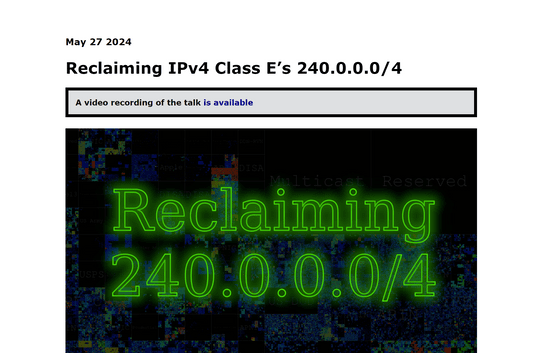Is it possible to reuse the final frontier in the face of IPv4 address exhaustion: Class E 240.0.0.0/4?

Network engineer Ben Cox wrote in a blog post that in some circumstances, the 'Class E space,' which is in a state of standardization limbo, could be used to fill the exhaustion of IPv4 addresses.
Reclaiming IPv4 Class E's 240.0.0.0/4

IP addresses are used to identify the other party when communicating over the Internet. The IPv4 address space is 32 bits, and only about 4.3 billion IP addresses can be allocated in total, so as the Internet population increases, there is a problem of depletion of newly allocated IP addresses .
The price of IPv4 addresses has been rising since the supply of new IPv4 addresses dried up, and cloud services such as AWS have revised their prices, such as charging for the use of IPv4 addresses that were previously free.
AWS announces that it will charge for the use of public IPv4 addresses, and will also start offering 'Public IPv4 Insight' for free - GIGAZINE

As the number of available IPv4 addresses dwindles, Cox suggests that we could reuse the 'Class E' IPv4 address space defined in RFC1112 .
The Class E space runs from 240.0.0.0 to 255.255.255.255 and contains 268,435,456 IP addresses. It was allocated as 'reserved for future use' during the classification in 1989 and has since been ignored as a relic of the past.
However, it is not possible to simply allocate new Class E space because it would cause compatibility problems with the many devices that already exist. It is possible to use Class E space as 'new IP addresses that can only be used by new devices,' but few people want 'new IP addresses that can only be used by new devices,' and such IP addresses that can only be used by a limited number of users already exist as IPv6.
On the other hand, when building a local network, Class E IP addresses can be used for routing as long as only the devices within that network are compatible with them, and their use has been confirmed by AWS and some companies .
According to Cox's research, the following devices are compatible with Class E processing:
- Linux distributions from 2008 onwards
- Android 2009 or later
・macOS/OSX from 2009 onwards
・OpenBSD after October 2022
However, the following devices are known not to work:
Windows
・FreeBSD
Cox also created a virtual network vendor test lab to see the network equipment in action.

The results are as follows. Class E addresses can be used by enabling them in the settings in Arista EOS 4.29 and JunOS 22, and Class E addresses can be used without any settings in RouterOS 7.7 and Cisco IOS XR. Class E addresses could not be used in Cisco IOS XE 16.12, Nokia SR-OS 21.7, Huawei VRP, and Extreme EXOS 32.
| vendor | Static Link IP | Routed OSPF Works |
| Arista EOS 4.29 | Yes (Extra Config) | Unknown |
| JunOS 22 | Yes (Extra Config) | Yes |
| RouterOS 7.7 | Yes | Yes |
| Cisco IOS XR | Yes | Yes |
| Cisco IOS XE 16.12 | No | No |
| Nokia SR-OS 21.7 | No | No |
| Huawei VRP | No | No |
| Extreme EXOS 32 | No | No |
Cox also tested a network that had both Class E address-enabled and non-E address-enabled routers on its routes.

Naturally, if you assign a Class E address to a device behind a router that does not support Class E addresses and send data to it, the data will be lost. Therefore, if you use Class E addresses for routing, all devices in the local network should be Class E address-compatible.

Cox reflected on his post, saying, 'While there is no general need to use Class E addresses, they can be useful if you have workloads that simply cannot be migrated to IPv6 and you have full control over your local network and can make all your devices Class E-compatible.'
Related Posts:
in Hardware, Software, Web Service, Posted by log1d_ts






